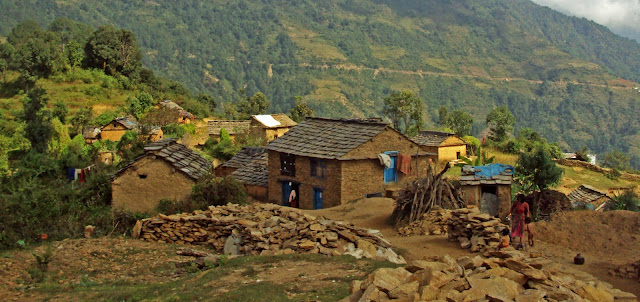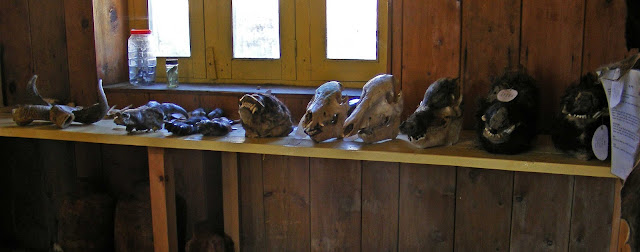The
slogan 'Wonderful Far-west' appears on most of the buses that run to Dhangadi
and Mahendranagar from Kathmandu. Whenever there is any discussion of the major
attractions in Far-west, the wondrous picture of Khaptad immediately flashes.
Khaptad is often presented as 'The Heaven on Earth' by its promoters. The area
was declared a National Park in 2040 B.S., comprising 225 km2 of
four hilly districts namely Doti, Bajhang, Bajura and Achham. But this heavenly
landscape has seen few international tourists in 32 years. Keep aside the
pilgrims who visit the area during the annual religious fairs of Ganga-Dashahara
and Janai Purnima and it will reveal that the flow of domestic tourists
is not significant either.
This
way or that way, I keep going!
I
was planned to go explore the lake Rara during Dasain vacation of 2011. One
of my friends had shown an interest of joining me. He requested me to shift it
after the festival and I agreed.
On
the day set for departure, I packed all my gears early in the morning and
called my supposed companion. He did not respond. I kept ringing his phone till
14:00 but he did not pick the phone. Around 14:30 a message came to my cell
phone that read, 'Sorry friend, I am unable to join!'
The
message annoyed me for a while. In no time, I dialed another friend, 'Would you
like to go to Rara?'
'Rara
will require more days. What about Khaptad?'
'Let's
do that.'
The
next day, three of us (Prajwal Byanju, Sanej Prasad Suwal and me) caught a
bus to Dhangadi.
As
usual, the bus played folk-duet songs (Lok-dohori), non-stop. At Dhangadi,
we took another bus to Silgadi, Doti.
The
bus took a break of about half an hour at Dipayal, headquarter of the far-western
development region.
'Hey
brothers, you seem to have returned from a foreign country. Where had you gone?'
a passenger asked us.
'We
came from Kathmandu, not from a foreign country. We are here to visit Khaptad'
I replied.
This
short conversation made us realize how uncommon the culture of travelling is in
Nepal.
The
bus rose from the shallow depression of Dipayal and dropped us on the hilly
market of Silgadi at 21:00 in the night. Dabal Bahadur Singh, who was in the
same bus with us, proposed that we spend the night at his house. We agreed
instantly.
I
was lying on the bed writing my diary when my phone rang.
'Happy birthday brother!' came the sound of
Ankit.
The
Hazmola shot
We
took leave of Dabal Bahadur dai early in the morning.
 |
| Silgadi bazaar |
For a short while we
walked on the black-topped road leading to Shantinagar. But soon we diverted
towards NTV tower, the trail being almost two hours earlier to reach Baglek
than the black-topped one.
 |
| Baglek |
Near the NTV tower, the Nepal army had managed a big
tank to provide drinking water facility to the travelers. A little ahead was
put a route map of Khaptad National Park (KNP). We had a pleasant impression.
Around
15:00 we reached Jhigrana, from where the boundary of KNP started.
 |
| Jhigrana |
Here we met
a group of fellow trekkers; Prawesh Paudel and Sambit Bhandari from Kathmandu
and Sabin Pathak and Janak Bhatt from Kailali. Our team grew in size.
Beyond
Jhigrana, the route went through a steep trail. Unfortunately there was no easy
availability of drinking water in this section. KNP could have drawn water from
streams into a tank through pipes, just like near the NTV tower!
On
the way, we met another group of Nepalese coming back from Khaptad. They told
us that they had an encounter with a wild boar (Sus scrofa) and advised
us to stay alert as the route ahead passed through a dense forest. Instead of
developing fear, my heart silently craved for an encounter with the wild boar. According
to their advice, we moved forward making noise every time we saw a rootling of
a wild boar and counting each other at intervals. We reached Bichpani after
four hours.
At
Bichpani, we stopped by the lodge run by KNP.
 |
| Bichpani |
Although the lodge had three
staffs, two of them had gone home leaving behind an old man. We asked him what
was available for dinner.
'Dal-bhat-tarkari'
he replied with a smile.
As
the old man was washing some potatoes, we asked him to put some of them in the
fire as the fire-cooked potatoes always taste better.
Having
taken dinner, Prajwal proposed that we celebrate my birthday. We gathered
firewood, made a camp fire and sang songs to the top of our voices. In the
meantime Prawesh came with a small bottle of locally-brewed alcohol. I told him
that I do not drink alcohol.
'Come
on, it's your birthday. You cannot decline.' everyone shouted.
We
finally made an agreement that I take just a few drops.
Prawesh
gave each of us a Hazmola (a digestive tablet easily available in
market) and said, 'Everyone should finish the alcohol in a single take and then
eat the Hazmola. We call this the Hazmola shot!'
(Note:
There is a popular Nepali television commercial advertisement of the Hazmola
that concludes, 'Je aauncha mazzale pachauncha' i.e. 'Eat
whatever, Hazmola will digest.')
The
rolling pastures
I
had difficulty sleeping the previous night because the zipper of my sleeping
bag was broken. The lodge had only one room to accommodate us and that too had
no door. Cold air kept hitting my body all night. I woke up very early (around
04:30), gathered some dry leaves and tried to make a fire. But I could not.
Everyone got up by 6:15 and we asked the old man for tea. But there was no
sugar left in the lodge. We had a glass of hot water each.
After
walking for a few minutes, our eyes caught sight of the rolling pastures. These
features stood behind the fame of KNP. All the exhaustion we had from yesterday
was gone upon seeing the wonderful landscape.
 |
| The rolling pastures of KNP |
We were walking by the bank of
Ghat khola, crossing the wooden bridges over the river at many places.
Stepping on the wooden bridges gave us a strange pleasure. We could not prevent
ourselves from taking a bath in the cold water. By the time we reached Tribeni,
the natural beauty had held us captive. Tribeni, a confluence of three small
rivers, is a holy place of the region, visited by a large number of pilgrims
during Ganga-Dashahara and Janai Purnima every year.
 |
| Tribeni |
A
walk of five hours from Bichpani brought us to the headquarter of KNP.
 |
| By the headquarter of KNP |
Some
horses and mules were grazing in the pastures and wild boar rootlings were
numerous. In the evening, the environment grew wilder by the howling of golden
jackals (Canis aureus) nearby. For some minutes, we were lost gazing at
the stars in the vividly open sky.
Wild
moments
The
rootlings of wild boar injected in us a desire of observing the animal. For
this, Prajwal, Sambit and me woke up at 04:00 the next morning and made our way
into the forest while it was still very dark. We did not see any wild boar. But
we had a sighting of two golden jackals which was a wonderful reward for our
jungle adventure!
While
returning we developed a fake story of our encounter with wild boars to tell to
rest of our lazy friends.
'We
had a narrow escape from a whole family digging the ground. They were so
fearsome.' I said.
'Don't
make a story. Show us a photo and we will believe!' Sanej argued.
'When
you are being chased by the wild boars, would you think of taking out your
camera or keep running?' Prajwal answered with a big smile on his face; our
fake story lost its charm.
We
paid a brief visit to the Khaptad Baba Ashram, the hermitage of late
Khaptad Baba, after whom the park has acquired its name.
 |
| The hermitage of late Khaptad baba |
Right here, we got to
have a delightful view of Mount Saipal and other mountains of the Saipal range.
 |
| Saipal range |
After
lunch, we went to visit Khaptad daha. We were told that the lake would
be reached in about an hour. But we could not locate it even after two hours. After
another half hour, the lake revealed itself.
 |
| Khaptad daha |
The
Khaptad daha lied serene in the middle of the forest. We enjoyed
watching the lake change its colour during our two hours stay by its shore. Adding
to our pleasure was a group of Nepal grey langurs (Semnopithecus nipalensis) jumping from one tree to
another.
 |
| Nepal grey langur |
While
returning to our camp, we found a skull of a dead langur on the forest floor.
We took it with us, cleaned it and submitted it to the museum managed by KNP.
The museum had exhibited skulls and skins of different animals found from the
park.
 |
| A small section of the KNP museum |
'To
have a fully satisfying impression of Khaptad, do come here during monsoon and
winter as well. The landscape will be adorned in a multitude of colors by
different species of wild flowers during monsoon. You know, this area itself
houses about 11% of flowering plants in Nepal. And during winter, you will
enjoy sliding down the rolling pastures that are covered in a thick layer of
snow.' told the caretaker of the museum.
Enjoyed the piece n will definitely go there some day. You've become a very good writer... keep it up !!
ReplyDelete(Hazmola Shot ;) )
You should go, it's a wonderful landscape :)
Deletethanks brother for writing it down in such an interesting way.
ReplyDelete(i didnt know you're a good writer!!!)
thanks for rekindling the awesome memories in my mind.
jolly moments!!
It was indeed a trip to remember, Sambit :)
DeleteThis comment has been removed by the author.
ReplyDelete